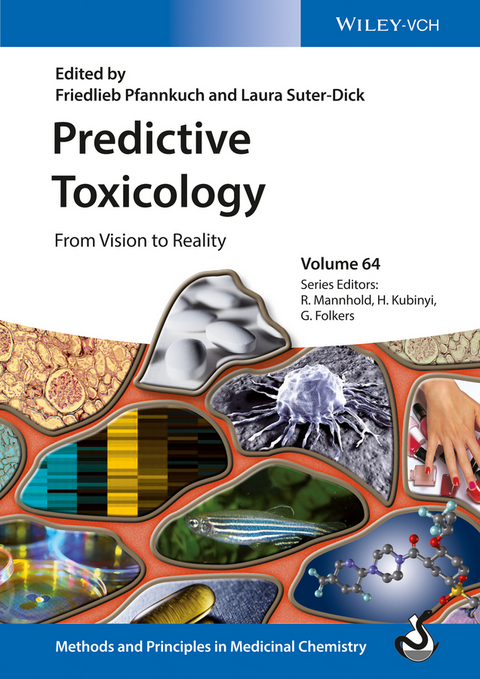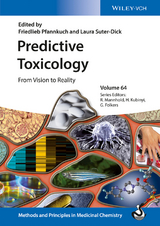Predictive Toxicology
Wiley-VCH (Verlag)
978-3-527-33608-1 (ISBN)
- Titel ist leider vergriffen;
keine Neuauflage - Artikel merken
Friedlieb Pfannkuch graduated as a physician from the Free University of Berlin, Germany and is Professor at the University of Basel, Switzerland. He has more than 27 years of experience in non-clinical safety assessment for all phases of drug development. During his career he was head of experimental toxicology at Ciba-Geigy in Basel, head of the non-clinical safety section at Yamanouchi Europe in the Netherlands, responsible for non-clinical nutrition safety at Roche Vitamins, and from 2003 until his retirement in 2011 he was a senior scientist in the global non-clinical drug safety department of F. Hoffmann-La Roche in Basel. He has contributed to international pharmaceutical consortia, such as toxicity testing of alternatives to CFCs propellants - IPACT, the ILSI task force on Food Safety in Europe and to working groups of the International Conference on Harmonization - ICH. IN the period from 2004-2009 he as the responsible manager of the European Commission's Research Framework Program 6 Project InnoMed: "Predictive Toxicology - PredTox". Laura Suter-Dick graduated as a biologist from the University of Buenos Aires (Argentina) and subsequently received her PhD from the Free University of Berlin (Germany). She has nearly 20 years of experience within the pharmaceutical industry, mainly in the field of toxicology. During her career in the pharmaceutical industry she worked as a scientist in the reproductive toxicology at Sandoz in Basel. She specialized in molecular toxicology (toxicogenomics) and in vitro assays at F. Hoffmann- La Roche Ltd., where she led the mechanistic toxicology. She has recently been appointed Professor for Molecular Toxicology at the Life Sciences School of the University of Applied Sciences and Arts Northwestern Switzerland. She acts as an external expert in several scientific panels and is also a Board Member of ESTIV (European Society of Toxicology in vitro).
Preface
INTRODUCTION TO PREDICTIVE TOXICOLOGY TOOLS AND METHODS
Computational Tools and Bioinformatics
Omics Technologies
Data Interpretation and Knowledge Management
Biomarker Development
Advanced In Vitro Systems and Stem Cell Research
Immunogenicity
Integration and Validation
Research Initiative/Collaborations
Concluding Remarks
IN SILICO TOXICOLOGY - CURRENT APPROACHES AND FUTURE PERSPECTIVES TO PREDICT TOXIC EFFECTS WITH COMPUTATIONAL TOOLS
Introduction
Prediction of Hazard
Prediction of Risk
Thoughts on Validation
Conclusions and Outlook
IN SILICO APPROACHES: DATA MANAGEMENT - BIOINFORMATICS
Introduction
Experimental Setup and Statistical Power
Properties of Different Omics Data
Statistical Methods
Prediction and Classification
Combining Different Omics Data and Biological Interpretations
Data Management
ROLE OF MODELING AND SIMULATION IN TOXICOLOGY PREDICTION
Introduction
The Need to Bring PK and PD in Predictive Models Together
Methodological Aspects and Concepts
Application During Lead Optimization
Application During Clinical Candidate Selection
Entry-into-Human Preparation and Translational PK/PD Modeling
Justification of Starting Dose, Calculatin of Safety Margins, and Support of Phase I Clinical Trial Design
Outlook and Conclusions
GENOMIC APPLICATIONS FOR ASSESSING TOXICITIES OF LIVER AND KIDNEY INJURY
Introduction
Toxicogenomic Approaches
Specific Applications of Toxicogenomics
Toxicogenomic Applications for the Better Understanding of Hepatotoxicity
Toxicogenomic Profiling of Nephrotoxicity
Limitations of Toxicogenomics
Conclusions
USE OF TOXICOGENOMICS FOR MECHANISTIC CHARACTERIZATION OF HEPATOCARCINOGENS IN SHORTER TERM STUDIES
Introduction
Toxicogenomics
Conclusions and Outlook
DISCOVERY AND APPLICATION OF NOVEL BIOMARKERS
Introduction
Novel RNA Biomarkers
DNA as a Biomarker
Novel Biomarkers: Beyond Nucleotide-Based Discovery
Summary and Outlook
PREDICTIVE TOXICOLOGY: GENETICS, GENOMICS, EPIGENETICS, AND NEXT-GENERATION SEQUENCING IN TOXICOLOGY
Introduction
Technological Advances
Applications in Toxicology
Summary and Outlook
BIOMARKERS AS TOOLS FOR PREDICTIVE SAFETY ASSESSMENT: NOVEL MARKERS OF DRUG-INDUCED KIDNEY INJURY
Need and Search for Novel Biomarkers of Kidney Injury
Urinary Biomarkers of Drug-Induced Kidney Injury
Genomic Biomarkers
Qualification and Use of Novel Kidney Injury Biomarkers in Preclinical Safety Assessment
Summary and Perspectives
THE USE OF RENAL CELL CULTURE FOR NEPHROTOXICITY INVESTIGATIONS
Introduction
In Vitro Renal Models
Stem Cells
Optimal Cell Culture Conditions
In Vitro Nephrotoxicity Assessment
Outlook
THE ZEBRAFISH MODEL IN TOXICOLOGY
The Need for a Physiologically Relevant Organ Model in Drug Toxicity Testing
Extensive Knowledge about Genetics, Development, and Physiology of D. rerio
Studies of Specific Organ Toxicities in Zebrafish Embryos and Larvae
PREDICTIVE METHOD DEVELOPMENT: CHALLENGES FOR COSMETICS AND GENOTOXICITY AS A CASE STUDY
Introduction
The Toolbox of Predicitve Methods
Genotoxicity as a Case Study
The Way Forward: Combining In Silico and In Vitro Tools
USING PLURIPOTENT STEM CELLS AND THEIR PROGENY AS AN IN VITRO MODEL TO ASSESS (DEVELOPMENTAL) NEUROTOXICITY
Introduction
Neurodevelopment In Vivo
Main Principle of In Vitro Test Systems to Model DNT
Requirements of an In Vitro Test System for DNT/NT
Modeling of Disease and Toxicant-Induced Damage
Using Stem Cells to Assess (Developmental) Neurotoxicity
Limitations
STEM CELL-BASED METHODS FOR IDENTIFYING DEVELOPMENTAL TOXICITY POTENTIAL
Introduction
Developmental Toxicity Screening: Past and Present
Pluripotent Stem Cells
Metabolomics
Stem Cell-Based In Vitro Screens for Developmental Toxicity Testing
Summary
IMMUNOGENICITY OF PROTEIN THERAPEUTICS: RISK ASSESSMENT AND RISK MITIGATION
Introduction
The Central Role of CD4+ T Cells
Generation of T-Cell Epitopes
Tolerance to Therapeutic Drugs
Tool Set for Immunogenicity Risk Assessment
Immunogenicity Risk Mitigation
The Integrated Strategy of Risk Minimization
Summary
REGULATORY ASPECTS
The History of Medicines Regulations in Brief
Impact on Drug Success of the Current ICH Nonclinical Testing Paradigm
Actions Taken for Increasing the Drug Development Success
Innovative Drugs: Impact on Nonclinical Development Strategies
Envisaging a Paradigm Change
Regulatory Actions Needed to Shift the Animal-Based Paradigm
Index
"This book is a sensible investment and recommended as a "must read" for toxicologists and pharmacologists to get a thorough understanding of the major challenges currently faced in realizing the objective of protecting human health using predictive toxicology." ( BTS Newsletter , 1 March 2015)
| Erscheint lt. Verlag | 21.11.2014 |
|---|---|
| Reihe/Serie | Methods and Principles in Medicinal Chemistry ; 64 |
| Mitarbeit |
Herausgeber (Serie): Raimund Mannhold, Hugo Kubinyi, Gerd Folkers |
| Verlagsort | Berlin |
| Sprache | englisch |
| Maße | 170 x 240 mm |
| Gewicht | 1016 g |
| Themenwelt | Studium ► 2. Studienabschnitt (Klinik) ► Pharmakologie / Toxikologie |
| Naturwissenschaften ► Chemie | |
| Schlagworte | Arbeitstoxikologie • Chemical Informatics • Chemie • Cheminformatik • Chemistry • Occupational Toxicology • Toxicology • Toxikologie • Wirkstoffforschung |
| ISBN-10 | 3-527-33608-7 / 3527336087 |
| ISBN-13 | 978-3-527-33608-1 / 9783527336081 |
| Zustand | Neuware |
| Haben Sie eine Frage zum Produkt? |
aus dem Bereich




